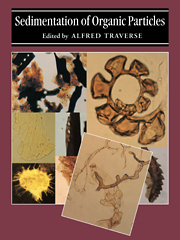Book contents
- Frontmatter
- Contents
- Editor's preface
- List of contributors
- I Introduction
- II Studies of palynosedimentation in modern environments
- 2 The sorting of spores and pollen by water: experimental and field evidence
- 3 Transport and deposition of pollen in an estuary: signature of the landscape
- 4 Pollen preservation in alkaline soils of the American Southwest
- 5 Wind and water transport and sedimentation of miospores along two rivers subject to major floods and entering the Mediterranean Sea at Calvi (Corsica, France)
- 6 Sedimentation of land-derived palynomorphs in the Trinity–Galveston Bay area, Texas
- 7 The genesis and sedimentation of phytoclasts with examples from coastal environments
- 8 Palynofacies of some recent marine sediments: the role of transportation
- 9 Maceral palynofacies of the Louisiana deltaic plain in terms of organic constituents and hydrocarbon potential
- 10 Organic sedimentation in a carbonate region
- 11 An approach to a standard terminology for palynodebris
- 12 Relationships of palynofacies to coal-depositional environments in the upper Paleocene of the Gulf Coast Basin, Texas, and the Powder River Basin, Montana and Wyoming
- III Reconstruction of late Cenozoic vegetation and sedimentary environments from palynological data
- IV Application of data on palynosedimentation to solution of geological problems
- V Appendix
- Index
3 - Transport and deposition of pollen in an estuary: signature of the landscape
Published online by Cambridge University Press: 06 January 2010
- Frontmatter
- Contents
- Editor's preface
- List of contributors
- I Introduction
- II Studies of palynosedimentation in modern environments
- 2 The sorting of spores and pollen by water: experimental and field evidence
- 3 Transport and deposition of pollen in an estuary: signature of the landscape
- 4 Pollen preservation in alkaline soils of the American Southwest
- 5 Wind and water transport and sedimentation of miospores along two rivers subject to major floods and entering the Mediterranean Sea at Calvi (Corsica, France)
- 6 Sedimentation of land-derived palynomorphs in the Trinity–Galveston Bay area, Texas
- 7 The genesis and sedimentation of phytoclasts with examples from coastal environments
- 8 Palynofacies of some recent marine sediments: the role of transportation
- 9 Maceral palynofacies of the Louisiana deltaic plain in terms of organic constituents and hydrocarbon potential
- 10 Organic sedimentation in a carbonate region
- 11 An approach to a standard terminology for palynodebris
- 12 Relationships of palynofacies to coal-depositional environments in the upper Paleocene of the Gulf Coast Basin, Texas, and the Powder River Basin, Montana and Wyoming
- III Reconstruction of late Cenozoic vegetation and sedimentary environments from palynological data
- IV Application of data on palynosedimentation to solution of geological problems
- V Appendix
- Index
Summary
Introduction
Pollen preserved in lake and peat sediments has been used to reconstruct changes in vegetation induced by climatic events (Davis, Spear, & Shane, 1980; Webb, Cushing, & Wright, 1983; Davis & Jacobson, 1985) and by anthropogenic alterations to the landscape (Brugam, 1978; Burden et al., 1986). Only recently has the record from estuarine sediments been similarly exploited (Brush, 1986; McGlone, 1988). In this chapter, we describe the general pathways of pollen in an estuary, and show from laboratory experiments and field observations how the transport and deposition of pollen in the estuary results in distributions in the sediments that record regional vegetation, land use and the effect of land use on rates and patterns of estuarine sedimentation. Our area of study is the Chesapeake Bay estuary extending between latitudes 37° and 39° 30' N in the mid-Atlantic region of the USA (Fig. 3.1).
Estuarine circulation
First, we examine the fluid motion, sediment motion, and salinity characteristics of Chesapeake Bay. Chesapeake Bay and many of its tributaries are partially mixed estuaries (Dyer, 1973), characterized by vertical, lateral and longitudinal gradients in salinity, but with no abrupt change from fresh to salt water as is found, for example, in the salt wedge environments of many fjords. On the other hand, Chesapeake Bay estuary is neither completely mixed nor homogeneous, as are estuaries characterized by large tidal flows and small river inflows. An example of an idealized, partially mixed estuary is shown in Figure 3.2A. When river water enters the estuary and meets ocean water, partial mixing occurs and causes lines of equal salinity to deform.
- Type
- Chapter
- Information
- Sedimentation of Organic Particles , pp. 33 - 46Publisher: Cambridge University PressPrint publication year: 1994
- 9
- Cited by

